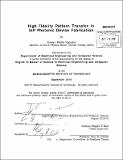High fidelity pattern transfer in InP photonic device fabrication
Author(s)
Kapusta, Evelyn Wallis
DownloadFull printable version (32.75Mb)
Other Contributors
Massachusetts Institute of Technology. Dept. of Electrical Engineering and Computer Science.
Advisor
Rajeev R. Ram.
Terms of use
Metadata
Show full item recordAbstract
The photonic industry is driven by the information ages demand for higher bandwidth. To meet the future demands of 10 Tbit networks, photonic integrated circuits (PIC) are required. Device performance is affected by everything from component coupling to electrical connectivity of the active components. However the most fundamental and often challenging aspect of photonic device fabrication is dimensional control. At 1550 nm, line width tolerance range between 1 pm to 0.05 pm.[1] Although these tolerances are easily achieved using lithography technology such as electron beam lithography (EBL) or 193 nm projection, neither are viable optical options for InP production.[2] The purpose of this thesis is to develop a fabrication process for InP Faraday rotators using standard, high throughput lithographic and etching techniques. The Faraday rotator is a 1.4 Jim InP-InGaAsP-InP waveguide with a line width tolerance of ± 0.07 pm.
Description
Thesis (S.M.)--Massachusetts Institute of Technology, Dept. of Electrical Engineering and Computer Science, 2010. Cataloged from PDF version of thesis. Includes bibliographical references (p. 158-162).
Date issued
2010Department
Massachusetts Institute of Technology. Department of Electrical Engineering and Computer SciencePublisher
Massachusetts Institute of Technology
Keywords
Electrical Engineering and Computer Science.